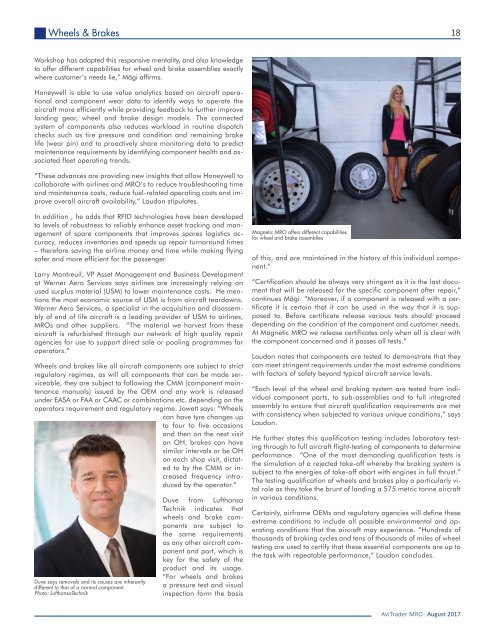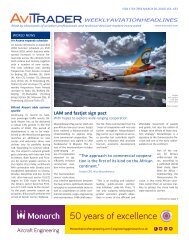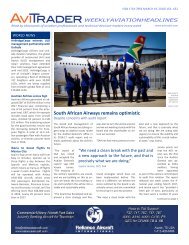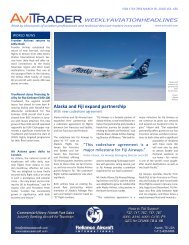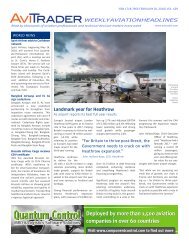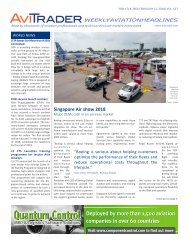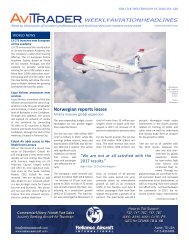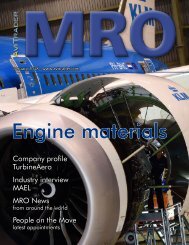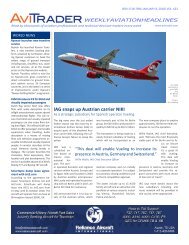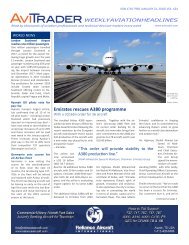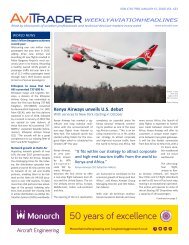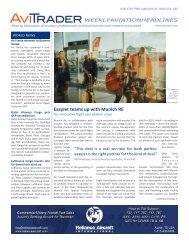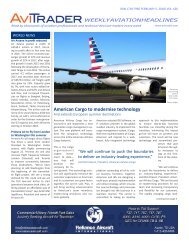You also want an ePaper? Increase the reach of your titles
YUMPU automatically turns print PDFs into web optimized ePapers that Google loves.
Wheels & Brakes<br />
18<br />
Workshop has adapted this responsive mentality, and also knowledge<br />
to offer different capabilities for wheel and brake assemblies exactly<br />
where customer’s needs lie,” Mägi affirms.<br />
Honeywell is able to use value analytics based on aircraft operational<br />
and component wear data to identify ways to operate the<br />
aircraft more efficiently while providing feedback to further improve<br />
landing gear, wheel and brake design models. The connected<br />
system of components also reduces workload in routine dispatch<br />
checks such as tire pressure and condition and remaining brake<br />
life (wear pin) and to proactively share monitoring data to predict<br />
maintenance requirements by identifying component health and associated<br />
fleet operating trends.<br />
“These advances are providing new insights that allow Honeywell to<br />
collaborate with airlines and <strong>MRO</strong>’s to reduce troubleshooting time<br />
and maintenance costs, reduce fuel-related operating costs and improve<br />
overall aircraft availability,” Laudon stipulates.<br />
In addition , he adds that RFID technologies have been developed<br />
to levels of robustness to reliably enhance asset tracking and management<br />
of spare components that improves spares logistics accuracy,<br />
reduces inventories and speeds up repair turnaround times<br />
– therefore saving the airline money and time while making flying<br />
safer and more efficient for the passenger.<br />
Larry Montreuil, VP Asset Management and Business Development<br />
at Werner Aero Services says airlines are increasingly relying on<br />
used surplus material (USM) to lower maintenance costs. He mentions<br />
the most economic source of USM is from aircraft teardowns.<br />
Werner Aero Services, a specialist in the acquisition and disassembly<br />
of end of life aircraft is a leading provider of USM to airlines,<br />
<strong>MRO</strong>s and other suppliers. “The material we harvest from these<br />
aircraft is refurbished through our network of high quality repair<br />
agencies for use to support direct sale or pooling programmes for<br />
operators.”<br />
Wheels and brakes like all aircraft components are subject to strict<br />
regulatory regimes, as will all components that can be made serviceable,<br />
they are subject to following the CMM (component maintenance<br />
manuals) issued by the OEM and any work is released<br />
under EASA or FAA or CAAC or combinations etc. depending on the<br />
operators requirement and regulatory regime. Jowett says: “Wheels<br />
can have tyre changes up<br />
to four to five occasions<br />
and then on the next visit<br />
an OH, brakes can have<br />
similar intervals or be OH<br />
on each shop visit, dictated<br />
to by the CMM or increased<br />
frequency introduced<br />
by the operator.”<br />
Duve says removals and its causes are inherently<br />
different to that of a normal component.<br />
Photo: LufthansaTechnik<br />
Duve from Lufthansa<br />
Technik indicates that<br />
wheels and brake components<br />
are subject to<br />
the same requirements<br />
as any other aircraft component<br />
and part, which is<br />
key for the safety of the<br />
product and its usage.<br />
“For wheels and brakes<br />
a pressure test and visual<br />
inspection form the basis<br />
Magnetic <strong>MRO</strong> offers different capabilities<br />
for wheel and brake assemblies<br />
of this, and are maintained in the history of this individual component.”<br />
“Certification should be always very stringent as it is the last document<br />
that will be released for the specific component after repair,”<br />
continues Mägi. “Moreover, if a component is released with a certificate<br />
it is certain that it can be used in the way that it is supposed<br />
to. Before certificate release various tests should proceed<br />
depending on the condition of the component and customer needs.<br />
At Magnetic <strong>MRO</strong> we release certificates only when all is clear with<br />
the component concerned and it passes all tests.”<br />
Laudon notes that components are tested to demonstrate that they<br />
can meet stringent requirements under the most extreme conditions<br />
with factors of safety beyond typical aircraft service levels.<br />
“Each level of the wheel and braking system are tested from individual<br />
component parts, to sub-assemblies and to full integrated<br />
assembly to ensure that aircraft qualification requirements are met<br />
with consistency when subjected to various unique conditions,” says<br />
Laudon.<br />
He further states this qualification testing includes laboratory testing<br />
through to full aircraft flight-testing of components to determine<br />
performance. “One of the most demanding qualification tests is<br />
the simulation of a rejected take-off whereby the braking system is<br />
subject to the energies of take-off abort with engines in full thrust.”<br />
The testing qualification of wheels and brakes play a particularly vital<br />
role as they take the brunt of landing a 575 metric tonne aircraft<br />
in various conditions.<br />
Certainly, airframe OEMs and regulatory agencies will define these<br />
extreme conditions to include all possible environmental and operating<br />
conditions that the aircraft may experience. “Hundreds of<br />
thousands of braking cycles and tens of thousands of miles of wheel<br />
testing are used to certify that these essential components are up to<br />
the task with repeatable performance,” Laudon concludes.<br />
<strong>AviTrader</strong> <strong>MRO</strong> - August <strong>2017</strong>


